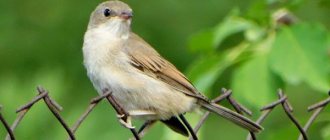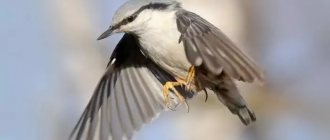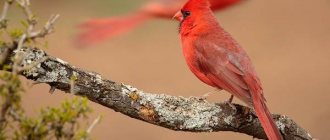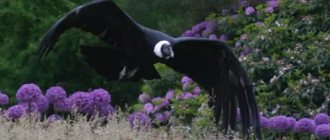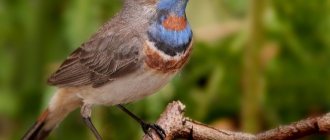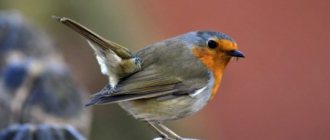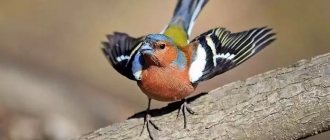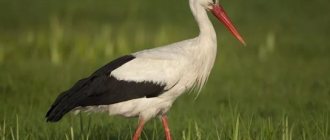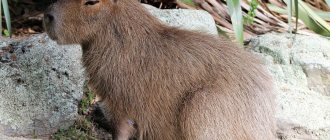| Latin name: | Otis tarda |
| Kingdom: | Animals |
| Type: | Chordata |
| Class: | Birds |
| Squad: | Crane-like |
| Family: | Bustards |
| Genus: | Bustards |
| Body length: | 75-105 cm |
| Wing length: | 60-80 cm |
| Wingspan | 190-260 cm |
| Weight: | 4-16 kg |
- 4.1 Where do bustards live?
- 12.1 European bustard
Appearance
— Advertising —
Bustard in profile - photo
Birds of this species have an extraordinary appearance. The voluminous, wide body with a convex chest rests on long, thick, three-toed legs. The short neck, slightly tilted back, is crowned by a small head compared to the body. The forehead smoothly flows into a long, large beak. The plumage of bustards is variegated, the color palette consists of red, brown, light gray and black colors. The head, neck, belly and legs have the same shade. The back, wings and tail are covered with small brown-black ripples. Long, stiff white feathers grow at the base of the beak - a distinctive feature of bustards. Powerful, unfeathered legs are adapted for rapid movement on horizontal surfaces. The tail is long, densely feathered, rounded at the end.
How are females different from males?
Bustards of different sexes differ from each other in feather size and color. Adult males are twice the size of representatives of the opposite sex. Females are not as elegant as males.
Male
Bustard male
– Advertisement –
Representatives of the stronger sex are very large birds. The body circumference is more than a meter. Males weigh between 7-16 kilograms, and their body length reaches 100-105 centimeters. The wingspan is more than two meters.
For most of the year, male bustards have the same plumage as females - the upper part is reddish-buff with black transverse stripes, and the underparts are light gray or white. In spring, the bird develops a brick-colored “collar” and long, thread-like “whiskers” of white color. The primary wings are brown, the secondary wings are brown with an admixture of white. This color lasts until the end of summer.
Female
Female bustard photo
Females weigh 4-8 kilograms. Body length is 75-80 centimeters, wingspan is 150-190 centimeters.
Females retain their feather color throughout the year. They, like males outside the nesting period, have mottled upperparts and almost white underparts. The eyes are black, the beak is light gray. The bare legs are grayish-green.
Features of character and lifestyle
Photo: Bustard female
These birds are diurnal and have one of the largest size differences between the sexes among vertebrates. For this reason, males and females live in separate groups almost the entire year, with the exception of mating season. This size difference also influences food requirements as well as breeding, dispersal and migratory behavior.
Females tend to flock together with relatives. They are more philopatric and sociable than males and will often remain in their natural area for their entire lives. During the winter, males establish a group hierarchy by engaging in violent, prolonged fights, striking other males on the head and neck, sometimes causing serious injury, behavior typical of bustards. Some bustard populations migrate.
Interesting fact: Bustards make local movements within a radius of 50 to 100 km. Male birds are known to be solitary during the breeding season, but form small flocks in winter.
The male is believed to be polygynous, using a mating system called "exploded" or "dispersed". The bird is omnivorous and feeds on insects, beetles, rodents, lizards and, sometimes, even small snakes. They are also known to feed on grass, seeds, berries, etc. When threatened, female birds carry young chicks under their wings.
Spreading
The photo shows the habitat of the bustard.
The nesting area of the bustard is extensive. Scattered outbreaks are found in Northern Europe (Austria, Czech Republic, Hungary, Bulgaria), North-West Africa (Morocco), the Middle East (Turkey, Iran), China, and the southern regions of Russia. Tiny populations of birds live in Kazakhstan, Mongolia, the Amur region, and the Black Sea region.
Where do bustards live?
Bustard in the grass in spring photo
Bustard is a bird of the steppes. The bustard prefers to settle on open tall grass plains, where feather grass and fescue grow. The bustard avoids mountainous and hilly areas and heavily moist lowlands. Prefers cereal steppes and open forage meadows. Settles along river valleys and forest lakes.
Rare bustard birds are of great interest to zoos, nurseries and private collectors of rare bird species.
In zoos and nurseries in many Russian cities (Moscow, Saratov, Penza, etc.) several individuals are kept for the purpose of reproduction. It is difficult to obtain offspring from captive birds, since in order to mate, bustards need to perform the necessary mating rituals, which are practically impossible to implement in an aviary. Even if you get fertilized eggs, difficulties arise with feeding the young. During the first week of life, chicks have to be fed with tweezers, which significantly complicates the feeding process and significantly slows down the development of the birds. In general, adult bustards feel comfortable in captivity. They willingly make contact with people, although when communicating with them, sudden movements and loud speech should not be allowed. Birds are very shy and experience prolonged stress from every excitement.
Habitat
The bustard is primarily a steppe bird. It lives on open plains without copses, meadows and fields. This is explained by the caution of the birds, since the free space there is visible far away.
During nesting, individuals stop in areas with high vegetation. There are also cases when bustards nest among crops of grain, sunflowers and other crops.
The bustard's habitat extends across North Africa and Eurasia, covering steppe regions from the Pyrenees to Mongolia.
Birds go to Turkmenistan, Tajikistan, and Northern Iran to spend the winter.
What does a bustard eat?
Bustards look for food in the grass.
Bustards have a mixed diet. The diet includes cereals, forbs, and large insects that live in the ground. Birds happily eat grasshoppers, Colorado potato beetles, locusts, and mole crickets. In the spring, they feast on their larvae and eggs. In the pre-dawn hours, bustards hunt small rodents (mice, ferrets), frogs and lizards. In hungry years, they do not hesitate to eat weakened, wounded relatives.
Bustard rare photo close up
In winter, when living creatures go deep underground, the basis of the bustard diet is vegetation. Bustards feed on seeds and shoots of various plants, buds and fruits. Plants of the legume, cabbage, and aster families are chosen for food. The gastrointestinal tract of the bird is poorly developed and does not accept the ingestion of coarse, fibrous feed, such as beets. From such food the bird suffers from intestinal volvulus and dies.
Bustards drink a lot and often. After each meal, they need to relieve their thirst at a watering hole. Birds are selective about water quality. The water should be clean, fresh and cool. In winter they eat snow.
Lifespan
Bustard preening its feathers
Bustards live up to 20 years. Males have a lower life expectancy than females. This is due to a large number of matings in a short period of time, as a result of which the male’s body cannot withstand such heavy loads. Chicks die due to the destruction of nests by predators and during the cultivation of fields with agricultural machinery.
Helmeted cassowary
- Weight: up to 83 kg
The helmeted cassowary (Casuarius casuarius) is native to the tropical rain forests of Indonesia, New Guinea and northeastern Australia. It prefers altitudes below 1100 m in Australia and 500 m in New Guinea. In general, the bird's height ranges from 127 to 170 cm, and its weight ranges from 36 to 50 kg for males and 68 kg for females. The maximum recorded height of these birds is 190 cm.
The helmeted cassowary is the largest extant Asian bird (since the extinction of the Arabian ostrich and earlier the moa in New Zealand) and the largest extant Australian bird (although the emu may be slightly taller).
Why was it called that?
Bustard runs
The word “bustard” is borrowed from the Proto-Slavic dictionary and goes back to the word “dropъty”, which in turn is formed from two words that mean “to run quickly” and “bird”. Because of the bustard's ability to run quickly, such a symbolic name was invented.
The steppe bird, the bustard, is popularly called the “whistlewing”, “laughing bird”, “shaker”. The names are associated with the habits of the bustard: during takeoff, the bird makes dull, drawn-out sounds, and while walking, slightly shakes its head.
Lifestyle
A bustard flies over the steppe.
To keep its heavy body in the air, the bird has to make deep flaps of its wings. The flight of the bustard is smooth, measured, but at the same time fast. To take off, a heavy bird needs a run. The bustard runs 30 meters against the wind, and then, with one strong flap of its wings, takes off.
Gray bustard in the steppe
Despite the fact that bustards fly well, they still prefer a terrestrial lifestyle. When walking, the bird's neck is extended, its head looks forward. The bustard's steps are measured and lazy. Unlike the crane's closest relative, the bustard does not dig up the ground in search of food, but collects it from the surface of the ground. It catches mammals with one strong blow of its beak. It swallows prey whole. For better digestion, the bustard swallows small pebbles, which help grind and digest food. If danger looms over the bird, it can hide in tall grass or run away to a safe distance. Bustards are active during the daytime. In the cool morning and evening hours they feed and during the day they rest in dense bushes.
Bustards are solitary by nature. During the warm season, they rarely gather in groups, preferring to rest and feed alone. In the autumn-winter period, in order to migrate, birds gather in small colonies consisting of same-sex birds. A group of bustards flies separately, at different heights.
Bustard with a bird on its back
Bustards lead a sedentary lifestyle; only in the northern regions are there a few colonies of birds migrating to the southern regions for the winter. Numerous studies have shown that bustards are adaptive birds that quickly adapt to the characteristics of a particular region. However, due to the lack of a special sebaceous secretion, the feathers of birds quickly become wet from rain and snow, which quickly freezes the body, making it difficult for the bird to move, much less fly. They are also forced to migrate by the lack of food, which remains under the thick snow.
Migratory birds, bustards, return to their nesting grounds in early spring. They return home in small flocks of 3-6 birds, moving only during the day. At the end of April, birds gather at lekking areas - open areas where the marriage ceremony and mating take place.
Popular message topics
- Animals
of the tundra The tundra is dominated by a harsh and rather unfavorable climate. In Russia, this natural zone extends from the Kola Peninsula all the way to Chukotka. Life in these natural areas is almost impossible due to the cold winds. - Modern geographical research
Nowadays, it is difficult to imagine that once people did not even know about the existence of America and Australia. They had no idea how far apart the continents were and how many seas there were. - Smell
Smell is the ability of the human body with the help of which we perceive and distinguish odors in this world. Maeterlinck, Maurice, who well noted in his own words that smell is the only luxury in the field of senses,
Reproduction
A male bustard attracts a female.
Females reach sexual maturity at 3-4 years, males at 5-6. At the mating site, each male has a certain territory with a diameter of 50 meters. Males, calling females, perform ritual dances, while the birds raise their tails and, lowering their wings, press the front part of their body to the ground. They turn their backs towards the females and defiantly stick out their “fifth point”. The clucking sound is getting louder. During mating, males breathe rapidly, their crop, throat feathers and “whiskers” swell. The head is pulled into the neck. Birds stomp in one place for 10-15 seconds, then blow air out of their throats and take the appropriate pose. After 5-7 minutes, the males repeat the enticing technique. Bustards are polygamous and do not create permanent pairs. The male tries to take possession of as many females as possible. Females also mate with 2-3 partners at once. Usually there are more females in a flock than males. Mating games last 1.5-2 months.
Nest
Bustard nest with eggs
The birds begin arranging the nest at the end of May. The nest is a small earthen hole measuring 25*10 centimeters. Only the female is engaged in the construction of the home. For laying, the expectant mother chooses a secluded place overgrown with thick grass. First, with the help of its beak, the bird “weeds” the area, freeing the ground from grass, then with its paws it makes a depression in the ground, giving it a rounded shape. The bottom is lined with grass and down. Bustard nests are built at a distance of 30-40 meters from each other.
Chicks
A bustard chick walks on a stone.
A female bustard lays 1-2 eggs. The egg is 7-9 centimeters long and up to 7 centimeters in diameter. The color of the shell is variegated - the base is greenish-brown, dotted with specks of different sizes of brown and dark gray. The shell is shiny.
The female incubates the chicks for 3-4 weeks. At this time, males go in small groups to molting areas. The female bustard sits quietly in the nest, hardly moves, and does not make any sounds. When a predator or a person approaches, the bustard tries to divert danger from the nest - the female runs away from the nest and pretends to be a wounded bird, and then, allowing the enemy to come close, attacks. In the early morning and evening, the female leaves the nest to feed. Forages for food at a distance of 400 meters from the nest.
Bustard chick in human hand
Chicks appear unevenly. For the first 3-5 days they move little, their eyes are closed. The skin is covered with light gray fluff. The basis of the diet of newborn bustards is ants and their eggs. The mother feeds the chicks, placing pieces of food into their open mouths. From the first days of life, the young begin to explore the area around the nest. After a week, the female takes the brood to the steppe, where the bustards will learn to forage on their own. At 35 days, a bustard chick weighs 1.5-2 kilograms. The young fledglings reach 40 days of life. By the end of summer, the birds unite in flocks and leave the nesting area. Until next spring, the mother protects the young and teaches them the wisdom of feathered life.
Nesting
The nesting period for bustards lasts from April to June. The time of egg laying depends on the air temperature and the region where the birds live. In the southern regions, bustards lay eggs at the end of April, in more northern regions - 2-3 weeks later, usually in early May. Nest construction is carried out exclusively by females.
After mating, males leave females, gather in groups and go to secluded places for spring molting. They do not take any part in arranging the nest, incubating eggs, or raising chicks. The female builds a nest directly on the ground; she can place it under the branches of bushes, in the middle of tall grass or on an open surface.
Sometimes she makes a nest in a plowed field. Females make nests no closer than 50 meters from each other, most often the distance between nests is several hundred meters. With powerful legs, she digs a hole 25-40 cm in diameter, lays grass and dry leaves on the bottom and compacts everything tightly. When grass grows around the nest in the summer, it perfectly camouflages the nest.
In one season, a female bustard makes only one clutch, which usually contains two eggs, rarely one or three. She takes them down one at a time with a period of 1-2 days. The shape of the bustard egg is ellipsoidal, similar to chicken eggs, but much larger - up to 7-9 cm in length. The color of the eggs can vary: from light brown to dark olive; they are not monochromatic, but have spots and specks of a darker shade. You may notice an oily sheen to the shell, which becomes more pronounced towards the end of the incubation period.
After laying eggs, the female begins to incubate them, which lasts three to four weeks. She sits tightly on the eggs. In case of danger, the bustard bends closer to the ground and freezes. The bird's camouflage color allows it to blend in with the surrounding vegetation. Twice a day, morning and evening, the female leaves the nest for about 40 minutes to feed. She tries not to move more than 400 meters from the nest. Ripe eggs hatch into small, feathered chicks. They quickly gain weight and within a month weigh two to three kilograms.
The female may lose her clutch, in which case she lays eggs again. Males, individuals who did not take part in reproduction, stick together, forming flocks of birds of the same sex. Such groups are joined by females who have lost their clutches. Sometimes flocks of males reach one hundred individuals.
Types of Bustards
Ornithologists distinguish two subspecies of bustards - European and East Siberian. Both are on the verge of extinction. The European and East Siberian bustards differ from each other in habitat and plumage color.
European Bustard
European bustard - photo
Latin name: O. t. tarda
Weight: 9-15 kg
Conservation status: category 3 – rare subspecies
Birds of the European species are painted in dark colors. The head, wings and tail are dark brown. On the back the pattern is unclear, the black lines are thin.
A hundred years ago, the European bustard lived in the steppes and forest-steppes of Europe and Asia. Today, focal concentrations of birds are observed in the Rostov region, the Lower Volga region (Ulyanovsk, Samara, Saratov and Volgograd regions). Groups of 3-6 couples live in Kalmykia and Stavropol, in the Orenburg region.
European bustard in the steppe
Small populations of bustards live in Ukraine, Kazakhstan, Spain, Portugal, Turkey and Iran. In all countries, the subspecies is recognized as endangered (the world population is 32 thousand birds).
East Siberian Bustard
East Siberian Bustard
Latin name: O. t. dubowskii
Weight: 9-15 kg
Conservation status: Category 2 - a species whose numbers are declining throughout its range
The East Siberian Bustard has a clear, bright dorsal pattern, with wide black stripes. Males grow thread-like tufts of white color on their heads every summer.
In Russia, the eastern race is found in Tyva, Buryatia, Chita, the Amur region and the Primorsky Territory. Outside Russia, small focal nesting sites have been observed in Mongolia and northern China.
Origin of the species and description
Photo: Bustard
The bustard is a member of the bustard family and the only member of the genus Otis. It is one of the heaviest living birds capable of flight and is found throughout Europe. Huge, robust, but majestic-looking adult males have a bulbous neck and heavy chest with a characteristic upturned tail.
The breeding plumage of males includes white whiskers 20 cm long, and their back and tail become more colorful. On the chest and lower part of the neck they have a stripe of feathers that are colored red and become brighter and wider with age. These birds walk upright and fly with powerful and regular wing beats.
Video: Bustard
There are 11 genera and 25 species in the Bustard family. The kori bustard is one of 4 species in the genus Ardeotis, which also contains the Arabian bustard, A. arabs, the great Indian bustard A. nigriceps and the Australian bustard A. australis. The Gruiformes lineage contains many relatives of the bustard, including trumpeters and cranes.
There are about 23 species of bustards, native to Africa, southern Europe, Asia, Australia and parts of New Guinea. The bustard has rather long legs adapted for running. They only have three fingers and are missing a back finger. The body is compact, held in a fairly horizontal position, and the neck stands erect, in front of the legs, like other tall running birds.
Enemies of the bustard
The main enemy of the bustard is the golden eagle.
Adult bustards rarely give offense to anyone. Females are attacked by golden eagles, steppe eagles and white-tailed eagles. On the ground, foxes, wolves, badgers and corsacs await the birds. Cats and steppe ferrets hunt for wounded birds.
Predators cause damage to the population by destroying the nesting grounds of bustards and eating bird eggs. Rooks, crows and magpies are involved in destroying nests. The birds wait until the frightened female leaves the nest and attack the brood.
Species status
Bustard among flowers
Bustard is recognized as an endangered bird species and is included in the Red Books of several countries and the International Union for Conservation of Nature, and is also protected by individual international conventions.
Uncontrolled hunting of these birds caused a sharp decline in the bustard population at the beginning of the 20th century. The number of birds in certain regions has also decreased due to the expansion of agricultural land and the introduction of new technologies in land cultivation. Bustards are known to lay eggs on the ground, which often led to eggs being buried by tractor equipment during harrowing or sowing. Bustards are very shy. Seeing a rattling car next to the nest, the females move from their place, leaving the nests forever.
There is less and less land left suitable for bustards to live comfortably. The areas where large concentrations of bustards once nested are being used for agricultural purposes. On such lands there is less food due to pesticides. Nesting here becomes impossible and the birds move away in search of better living conditions.
Over the past 20 years, conservation programs have been created to restore the bustard population. First of all, specialists began protecting the areas where the bird disappeared. Nature reserves have been created where there is no agricultural activity, hunting is completely prohibited and birds can feel calm. In European countries and Russia, special nurseries have been organized in which bustards reproduce naturally. In specially created laboratories they carry out artificial incubation of eggs.
Interesting facts about the bird
The bustard is the heaviest flying bird in our country. Interestingly, it is symbolic. In Africa, the bustard is associated with fertility, as well as the deep relationship between earth and air. In Russia, this bird is a symbol of the Saratov region.
The restoration of the number of bustards in our country is being carried out by the Saratov branch of the Institute of Ecology and Evolution. A. N. Severtsov Russian Academy of Sciences. The experience of this institution in restoring the population of the species is widely known not only throughout the country, but also beyond its borders. The program attracted the interest of British specialists, and in 2003 the British consortium “Big Bustard” and the Russian Academy of Sciences signed a Memorandum of Cooperation to restore the natural bustard population. After all, in England the bustard is one of the most beloved birds, as well as one of the symbols of the country. It is depicted on coats of arms, bars, clubs and various organizations are named after the bustard, but there are very few bustards left in the wild nature of Foggy Albion.
Bustard voice
Bustards shout at each other.
The sounds that a bustard makes can hardly be called singing. More like bleating, rumbling, hiccupping. Male bustards “talk” more than females. Their voice is low and hoarse. Words consist of unvoiced consonant sounds “ikkrkh”, “kkrkh”, “kryhh”. Females are more silent and emit warning signals to the chicks in times of danger. Excited and frightened birds bubble loudly, the sounds are short, repeated once every 5-6 seconds.
Somali ostrich
- Weight: up to 130 kg
The second largest surviving bird is the Somali ostrich (Struthio molybdophanes). This is a large flightless bird native to the Horn of Africa. It also lives in northeastern Ethiopia and throughout Somalia. The bird was previously considered a subspecies of the common ostrich, but in 2014 it was identified as a separate species.
A male Somali ostrich can weigh up to 130 kg.

